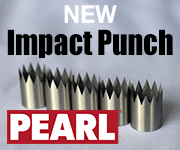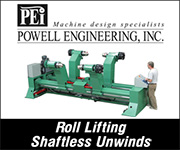Featured Stories
-
Elevating Pouch Manufacturing with Pearl Technologies' Cutting-Edge Solutions
For manufacturers seeking efficiency, precision, and safety in pouch production, Pearl delivers unmatched innovation across three standout... -
Faster Product Composition Analysis Equals Better Quality Assurance
Near Instant Testing and Reduced Costs to be Found -
Methods to Precisely Measure Tension and Web Control
How to Control Automatically Within Set Parameters
News | New Products
-
PACKZ 11 Launches with Industry-First RIP Integration
Plus extended CF2 format and automated support for 2-D Barcodes as Required by the Sunrise 2027 Initiative
-
Double E Group Acquires CAC, Further Enhancing its Strength in the Global Converting Industry
Double E Group, a global leader in converting components and web handling technology, has announced its acquisition of Converter Accessory Corporation (CAC)
-
Nobelus Launches Entry-Level Komfi® Thermal Laminator
FINISHING SOLUTIONS SUPPLIER OFFERS NEW JUNIOR 52 LAMINATING SYSTEM
-
Double E Group Mourns the Loss of Founder and Converting Industry Pioneer, Richard Edward Flagg
Double E Group announces with profound sadness the passing of its founder, Richard Edward “Ed” Flagg, on June 23, 2025. He was 85.
-
Convertech Brand to Fully Transition to Double E Group Same Team, Same Excellence, Unified Name
Double E Group has announced that Convertech, one of its subsidiaries and a trusted provider of core chucks and shaft solutions for the converting industry, will now operate solely under the Double E Group brand.
-
Pulse is Making Print Simple at Labelexpo Europe 2025
Narrow web ink specialist Pulse is Making Print Simple at Labelexpo Europe 2025, as it challenges flexo printers to rethink how they work and shows solutions that turn production bottlenecks into revenue generators.
-
ROTOCON to debut at Labelexpo Europe with three machine demonstrations
ROTOCON will make its Labelexpo Europe debut, exhibiting together with HS Machinery on stand 4D21.
Expert Advice
Testing Equipment: Does Your Lab Measure Up?
- Published: August 01, 2003, By Claudia Hine, Senior Editor
Performance. It's a key word for converters whose products have to meet rigorous standards and customer expectations. To predict product performance or to verify it, you can turn to precision instrumentation to get the job done.
Due to the number of components involved in a single label product — facestock with top coat or overlaminate, adhesive, release coating, and liner — testing can be a difficult task, says Gary Avalon, group marketing director at Chemsultants International, Network, Mentor, OH (chemsultants.com).
“A probe material analyzer is capable of sensing both compressive and tensile forces while probing into a variety of materials,” he says. “Through the use of custom probes and sample fixtures, one can generate information relating to all of the components. These could include adhesion, tack, and shear behavior for the adhesive layer and stiffness, compressibility/resilience, or burst/tear strength of the face and liner stocks. Taken together, this data can lead to a better understanding of how materials will convert and whether they will work as intended in the final product.”
The test instrument can be fitted with various probes and sample fixtures. For example, if you want to characterize bulk polymers, you'll need a fixture to hold wet samples, along with a probe to test rheological or viscoelastic behavior.
If you want to test finished labels, then fixtures and probes geared to test bonding strength or peel adhesion and tack are required. Stiffness or hardness of webstocks require yet another setup.
A material's coefficient of friction (COF) or “slip” is another property you may test in order to predict how fast your equipment can run without interruptions such as jamming and misregister. Before investing in a new slip and friction tester, determine whether you're interested in just the static COF or the static and kinetic COF, says Richard Young, VP of sales for Testing Machines, Islandia, NY (testingmachines.com).
“Many plants are just looking for a number for static COF,” he explains. “A motorized, inclined plane COF tester does a good job as an instant test, but we have discovered inherent variability in results. Technicians will set the sled on the platform at an incorrect angle (not perfectly square), or leave the sled on the platform for different amounts of time (changing the dwell time), or take the wrong angle reading (which needs to be read off the tester), or make an incorrect calculation from the manual reading.
“Inclined plane or slide angle testers are sufficient in fewer and fewer applications, and more and more customers are opting for the horizontal plane COF tester, which provides results with much higher integrity, eliminates operator error, and gives the tester more choices in evaluating results, including kinetic COF readings,” he says.
Horizontal bed COF testers square the sled perfectly, allow the tester to select the travel length and speed of the test, and program the dwell time, Young adds. Options such as temperature control of the test bed, accessories such as a glass plate surface (an ASTM standard), an attachment for measuring peel strength, and calibration weights for self-calibration are available as well.
The additional information and insight into the performance of the materials you're using can be of great value. It can be used to establish tighter specifications on raw materials, process tolerances, and finished converted products, says Avalon. “This leads to improved quality and production efficiency, not to mention product performance.”
Restrictions of time and space limit the number of companies, products, and trends that we can discuss in these reports.For additional information, see PFFC's features and departments each month, consult the June Buyers Guide, and check pffc-online.com.






















